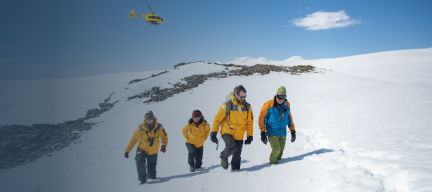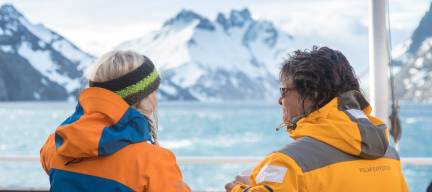Falklands, South Georgia, and Antarctica Explorers and Kings
Starting from
- Ushuaia, Argentina
Ships
- Ocean Explorer
Departures


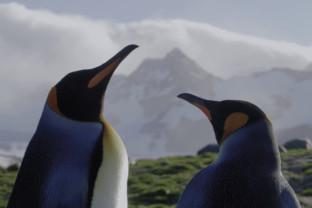

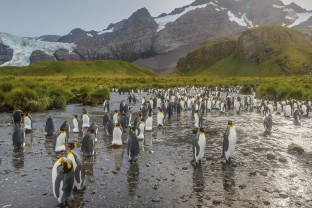

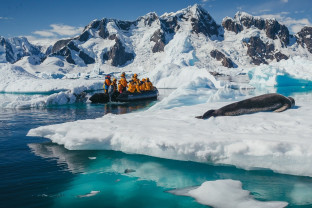

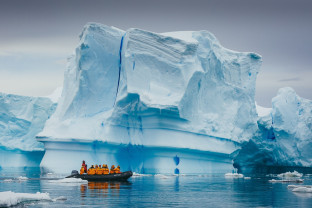
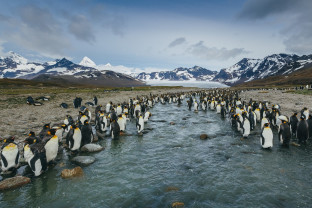

Expedition Overview
The Falklands (Malvinas), South Georgia & Antarctica itinerary is the fastest way to get to the rarely visited Falkland Islands and South Georgia before stepping foot on the 7th Continent. Stroll the quaint English village of Stanley in the Falklands, wander the islands’ sandy dunes, and birdwatch at rugged seabird cliffs. In South Georgia, discover the beaches where king penguins breed – one of the highest densities of animal life on earth – and learn about the rich historical legacy of the places you visit. Both islands are known as meccas for wildlife with epic displays of animals congregating by the thousands. Then, explore the stunning Antarctic Peninsula and enter a world of ice, snow and natural wonders. Pursue your personal passions with a choice of rewarding activities and our extensive educational program.
Highlights
Wander the quaint British town of Stanley in the Falkland Islands (Islas Malvinas)
See South Georgia’s incredible wildlife, including 30 breeding bird species and four penguin species
Follow in the wake of Sir Ernest Shackleton’s perilous voyages to South Georgia and pause for a moment at his grave site
Explore the Antarctic Peninsula by ship, Zodiac and foot
Enjoy presentations on wildlife, history, glaciology & geology by our onboard polar experts
Immerse yourself in the icy realm of the Antarctic, with an optional kayaking excursion
Find Your Ideal Itinerary
From Ushuaia, Argentina, 20 days, on Ocean Explorer
- Duration
- 20 days
- Departing from
- Ushuaia, Argentina
- Ship
-
Ocean Explorer
Learn more about the ship - Starting from
- $24,371 USD per person

Your gateway for this expedition is Ushuaia, Argentina. Located within the Tierra del Fuego archipelago, Ushuaia has a small-town feel yet boasts many shops, museums, cafés and restaurants that you can enjoy before your voyage. If you’re feeling adventurous, the nearby Tierra del Fuego National Park and Martial Glacier offer plenty of outdoor activities, such as hiking.
As you embark, the anticipation grows. Trade your land legs for sea legs, meet and greet your fellow travelers and get acquainted with your ship. Since every Antarctic adventure presents new opportunities and experiences, embarkation day is just as exciting for your Expedition Team as it is for you. On board your team will be there both to ensure your comfort and safety as well as help make your wildlife dreams come true.
Your days at sea are filled with presentations led by your Expedition Team on photography, wildlife, glaciology, and history. In between presentations, spend time on deck looking for wildlife or chatting with your shipmates over a drink at the bar.
Upon your arrival in the Falklands (Malvinas), your camera will get its first real workout capturing the abundant wildlife and rugged feel of this sub- Antarctic region. The archipelago contains two main islands, East Falkland and West Falkland, which you will explore during daily excursions.
Stanley, also known as Port Stanley, is often a favored landing site, as the town offers a unique British outpost feel, complete with eclectic charm. You’ll be free to explore, grab a pint at the local pub or visit the cathedral and museum.
In terms of wildlife, the archipelago is home to Magellanic, gentoo and southern rockhopper penguins. If you’re lucky, you may even spot king penguins here as well! You can expect to see black- browed albatross, plus two endemic bird species—the flightless Falkland steamer duck and, possibly, the elusive Cobb’s wren.
Your expert education team will enrich your understanding of the local flora and fauna, making the most out of your time in the Falklands.
Sailing southeast to South Georgia, you’ll officially enter Antarctic waters once you cross the Antarctic Convergence, an invisible biological boundary encircling the continent. This meeting of oceans, where the cold Antarctic waters mix and mingle with the warmer waters of the Indian, Pacific and Atlantic Oceans, helps nourish the abundance of krill that attracts whales, seals, and birdlife to this part of the world. Your Expedition Team will notify you when you cross this invisible yet important line, and also look out for the seabirds and marine life that frequent this nutrient-rich area.
This remote, mountainous island was a popular stop for many historic Antarctic expeditions and was once known for whale– and seal–hunting. Today, island wildlife populations are rebounding, but you’ll still see remnants of old whaling stations and other abandoned outposts.
One significant and historic site is the grave of the great explorer Sir Ernest Shackleton. You can visit his grave at the settlement of Grytviken, which is also home to an old whaling station, plus a museum, gift shop, church and small research station.
Although South Georgia’s history is an important attraction to the island, its incredible densities of wildlife make it truly memorable. Each landing you make on South Georgia, often referred to as the Galapagos of the Southern Sea, will open your eyes to the wondrous lives of new, enthralling creatures.
One day you may see colonies with hundreds of thousands of pairs of king penguins waddling on shore, and the next, you may visit another beach inhabited by hundreds of fur or elephant seals. The grasses, mountains and beaches of South Georgia all play an important role in the breeding and survival of different species on the island. This fragile and interwoven relationship is something your Expedition Team will instill in you during your time here.
Say goodbye to the king penguins as you leave for your next destination: Antarctica! Your days at sea are filled with presentations, workshops, and social activities led by your Expedition Team.
If conditions allow, we may attempt landfall on the South Orkney Islands, our first official stop in Antarctica.
The most common reaction upon reaching the Antarctic Continent is a sense of reverence and awe. The experience is beyond words, since few places are as untouched and enduring as Antarctica.
You will discover that Antarctica is a land of extremes. At one moment you’ll be overcome with a feeling of complete isolation and silence, and at the next moment you’ll be inspired by nature as a calving glacier crashes into a brilliant blue sea or a curious penguin waddles by to observe the human.
Your Expedition Team will take care of you at each excursion, whether you are Zodiac cruising, visiting a historical site or consorting with penguin colonies.
Chinstrap, Adélie and gentoo penguins are found here, along with Weddell, fur, crabeater and leopard seals. During Zodiac cruises, keep an eye out for Antarctic whales such as minkes, as you may get a chance for an intimate experience with these majestic animals. Each day and each excursion will present a new collection of creatures to entertain you and keep your camera busy.
As exciting as the Zodiac excursions and landings are, perhaps you’ll treat yourself to an extra-special Antarctic experience by partaking in an optional paddling excursion (at an extra cost) or cast reason aside and jump into Antarctic waters for the Polar Plunge!
After more than two weeks of endless wildlife encounters, your journey home begins. Crossing the Drake is your unofficial rite of passage, completing your Antarctic adventure. Enjoy your final moments celebrating with your fellow shipmates and savor the silence of the sea as long as you can.
After breakfast aboard the ship, it is time to part ways and say goodbye to your Expedition Team. Airport transfers will be provided for those departing on the first homeward flights. Other guests will be transferred to town.
From Ushuaia, Argentina, 20 days, on Ocean Explorer
- Duration
- 20 days
- Departing from
- Ushuaia, Argentina
- Ship
-
Ocean Explorer
Learn more about the ship - Starting from
- $26,967 USD per person

Your gateway for this expedition is Ushuaia, Argentina. Located within the Tierra del Fuego archipelago, Ushuaia has a small-town feel yet boasts many shops, museums, cafés and restaurants that you can enjoy before your voyage. If you’re feeling adventurous, the nearby Tierra del Fuego National Park and Martial Glacier offer plenty of outdoor activities, such as hiking.
As you embark, the anticipation grows. Trade your land legs for sea legs, meet and greet your fellow travelers and get acquainted with your ship. Since every Antarctic adventure presents new opportunities and experiences, embarkation day is just as exciting for your Expedition Team as it is for you. On board your team will be there both to ensure your comfort and safety as well as help make your wildlife dreams come true.
Your days at sea are filled with presentations led by your Expedition Team on photography, wildlife, glaciology, and history. In between presentations, spend time on deck looking for wildlife or chatting with your shipmates over a drink at the bar.
Upon your arrival in the Falklands (Malvinas), your camera will get its first real workout capturing the abundant wildlife and rugged feel of this sub- Antarctic region. The archipelago contains two main islands, East Falkland and West Falkland, which you will explore during daily excursions.
Stanley, also known as Port Stanley, is often a favored landing site, as the town offers a unique British outpost feel, complete with eclectic charm. You’ll be free to explore, grab a pint at the local pub or visit the cathedral and museum.
In terms of wildlife, the archipelago is home to Magellanic, gentoo and southern rockhopper penguins. If you’re lucky, you may even spot king penguins here as well! You can expect to see black- browed albatross, plus two endemic bird species—the flightless Falkland steamer duck and, possibly, the elusive Cobb’s wren.
Your expert education team will enrich your understanding of the local flora and fauna, making the most out of your time in the Falklands.
Sailing southeast to South Georgia, you’ll officially enter Antarctic waters once you cross the Antarctic Convergence, an invisible biological boundary encircling the continent. This meeting of oceans, where the cold Antarctic waters mix and mingle with the warmer waters of the Indian, Pacific and Atlantic Oceans, helps nourish the abundance of krill that attracts whales, seals, and birdlife to this part of the world. Your Expedition Team will notify you when you cross this invisible yet important line, and also look out for the seabirds and marine life that frequent this nutrient-rich area.
This remote, mountainous island was a popular stop for many historic Antarctic expeditions and was once known for whale– and seal–hunting. Today, island wildlife populations are rebounding, but you’ll still see remnants of old whaling stations and other abandoned outposts.
One significant and historic site is the grave of the great explorer Sir Ernest Shackleton. You can visit his grave at the settlement of Grytviken, which is also home to an old whaling station, plus a museum, gift shop, church and small research station.
Although South Georgia’s history is an important attraction to the island, its incredible densities of wildlife make it truly memorable. Each landing you make on South Georgia, often referred to as the Galapagos of the Southern Sea, will open your eyes to the wondrous lives of new, enthralling creatures.
One day you may see colonies with hundreds of thousands of pairs of king penguins waddling on shore, and the next, you may visit another beach inhabited by hundreds of fur or elephant seals. The grasses, mountains and beaches of South Georgia all play an important role in the breeding and survival of different species on the island. This fragile and interwoven relationship is something your Expedition Team will instill in you during your time here.
Say goodbye to the king penguins as you leave for your next destination: Antarctica! Your days at sea are filled with presentations, workshops, and social activities led by your Expedition Team.
If conditions allow, we may attempt landfall on the South Orkney Islands, our first official stop in Antarctica.
The most common reaction upon reaching the Antarctic Continent is a sense of reverence and awe. The experience is beyond words, since few places are as untouched and enduring as Antarctica.
You will discover that Antarctica is a land of extremes. At one moment you’ll be overcome with a feeling of complete isolation and silence, and at the next moment you’ll be inspired by nature as a calving glacier crashes into a brilliant blue sea or a curious penguin waddles by to observe the human.
Your Expedition Team will take care of you at each excursion, whether you are Zodiac cruising, visiting a historical site or consorting with penguin colonies.
Chinstrap, Adélie and gentoo penguins are found here, along with Weddell, fur, crabeater and leopard seals. During Zodiac cruises, keep an eye out for Antarctic whales such as minkes, as you may get a chance for an intimate experience with these majestic animals. Each day and each excursion will present a new collection of creatures to entertain you and keep your camera busy.
As exciting as the Zodiac excursions and landings are, perhaps you’ll treat yourself to an extra-special Antarctic experience by partaking in an optional paddling excursion (at an extra cost) or cast reason aside and jump into Antarctic waters for the Polar Plunge!
After more than two weeks of endless wildlife encounters, your journey home begins. Crossing the Drake is your unofficial rite of passage, completing your Antarctic adventure. Enjoy your final moments celebrating with your fellow shipmates and savor the silence of the sea as long as you can.
After breakfast aboard the ship, it is time to part ways and say goodbye to your Expedition Team. Airport transfers will be provided for those departing on the first homeward flights. Other guests will be transferred to town.
Your Life Onboard






Enjoy panoramic views while you mingle in our comfy lounges, or head outside and chat with fellow adventurers on the wraparound deck. Our social spaces foster connections & shared experiences.

Engage with world-class experts in our auditorium. Presentations cover wildlife, history, marine biology, ecology, & geology, to enhance your polar knowledge & excitement for exploration.

Enjoy onboard amenities, attend lectures, or watch for wildlife from our observation decks. Sea days offer a perfect blend of education, relaxation, and anticipation.

Find tranquility in our well-stocked library, perfect for reading or quiet contemplation. The glass-domed Observation Lounge offers a peaceful retreat to reflect & enjoy awe-inspiring polar views.

Prepare for off-ship excursions in our spacious mudroom. Kayak, paddleboard, or take a plunge in polar waters. Stay active onboard with our gym, outdoor track, and pool facilities.

What’s Included
Specialist Expedition Leaders
Our team is comprised of the most professional and passionate Expedition Leaders in the world, who bring a wide range of experience and expertise to every adventure.
Immersive Off-ship Activities
Itineraries are packed with adventure options designed to immerses travelers in the polar wilderness, enabling them to connect with the natural wonders of their surroundings.
On-Ship Experiences & Facilities
Designed for comfort and adventure, each ship accommodates no more than 200 guests. Facilities include comfortable cabins, exceptional dining options, wellness treatments, and breathtaking panoramic views of the polar landscape.
Food & Beverages
Premium dining, with a wide selection of options that accommodate a variety of dietary preferences.
Quark Expedition Perks
Complementary Wi-Fi, alcohol on all voyages, and the Official Quark Expeditions parka to take home.
Transfers
Select voyages include essential transportation and accommodation arrangements for guests, ensuring seamless travel to and from the expedition starting point.
International airfare & visa expenses, travel insurance, mandatory expedition gear, on-ship expenses, adventure options and trip extensions are not included.
Expedition Ships
Ocean Explorer
Ship Amenities
- Main Dining Room
- Private Dining Room
- The Latitude Bar
- Library
- Dry Sauna
- Fitness Center
- Jacuzzis
- Observation Lounge
Ship Features
- Two Story Library
- Leading Edge Sustainability
- Ulstein X-Bow
- High Observation Outdoor Decks
- Quiet and Comfortable
- Stunning Interior Design

e37f6ddb-dd1c-4148-a821-95d06a8dd4fc

b898271c-219e-4203-bd40-20be0a749fc7

9936371e-f5e5-4f46-aa68-80f1f3e4abcf

c7c98073-86db-4545-997a-d37977a1139c

c10e9293-dea7-4f37-a3a2-c9832f5403a1

ebf167b4-b13f-44d4-8e88-3f179476f005
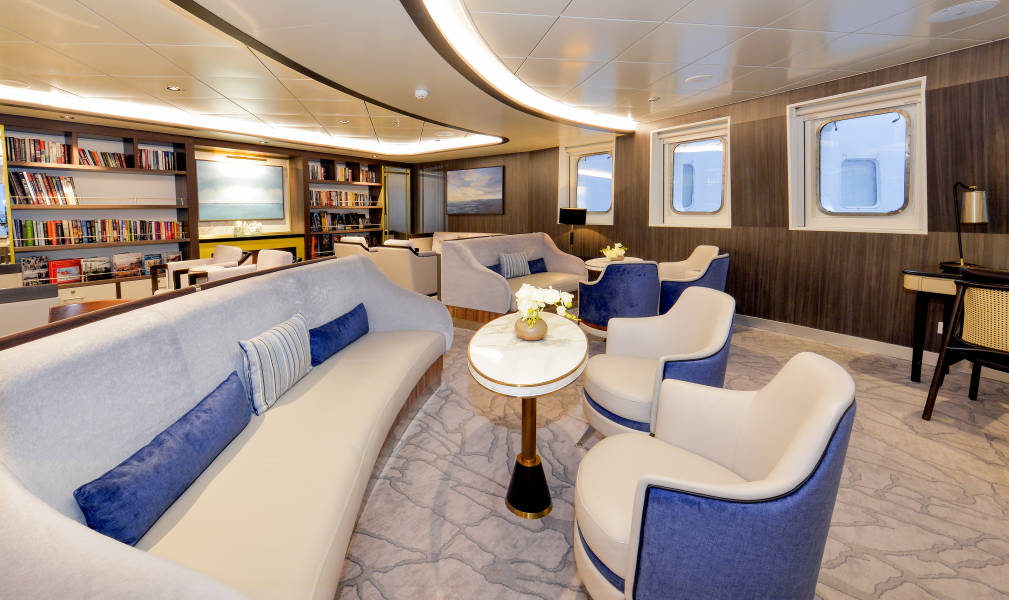
OEX_DiscoveryLibrary_DSC1660

d50510ef-b878-45b2-bcd5-c25e88cc8c37

cdfd7040-26ba-45e8-83b7-695aca545ed8

b2091fec-a6b7-47ac-91b1-d8b4641d0b78

cc146e56-9ff2-4541-86a5-5ed88d5d7648

16f6dded-02e4-49f4-88ec-086939a83ce3
Deck Plans & Cabins


Cabin Options

Studio Single


Cabin Options

Veranda Stateroom
Located throughout the ship and approximately 208 sq. f. (19.3 sq. m,) in size, these cabins have one double bed that can be configured into two singles, and seperate sitting area furnished with two club chairs and a reading table. There is a floor to ceiling glass view that opens to a walkout balcony. There is also a desk and chair, TV, state of the art ‘infotainment’ system and private bathroom with shower, vanity and heated floor. Note: 611 and 612 do not have the club chairs and a reading table.

Deluxe Veranda Forward
Located on Deck 4 and approximately 182 sq. f. (16.9 sq. m,) in size, these cabins have one double bed that can be configured into two singles. There is a floor to ceiling glass view that opens to a walkout balcony. There is also a desk and chair, TV, state of the art ‘infotainment’ system and private bathroom with shower, vanity and heated floor.

Veranda Suite
Located throughout the ship and approximately 205 sq. ft. (19.2 sq. m,) in size, these cabins have one double bed that can be configured into two singles, and seperate sitting area furnished with a sofa-bed. There is a floor to ceiling glass view that opens to a walkout balcony. There is also a desk and chair, TV, state of the art ‘infotainment’ system and private bathroom with shower, vanity and heated floor.


Public Spaces & Amenities

Main Dining Room
Contemporary meets cozy in this modern dining room with its stylish lighting and contemporary art. Located on Deck 5, the Main Dining Room seats 144 guests, and features expansive floor-to-ceiling windows that open onto the spectacular polar wilderness.

Private Dining Room
Tasteful and intimate. This stylish, private dining room on deck 5 provides a relaxed dining experience—with views of the polar landscape—for up to 36 guests.

The Latitude Bar
A popular social hub on Deck 5, the beautifully-lit Latitude Bar—with its lush sofas and faux marble-topped end tables—is large enough to seat 46 and is ideal for enjoying a quiet drink on your own or hanging out with friends.


Cabin Options

Junior Suite
Located on Deck 6 and approximately 298 sq. f. (27.7 sq. m,) in size. These 2-room suites have one double bed that can be configured into two singles in the inner bedroom and an outer sitting room furnished with a sofa-bed, and activity table for two. From the bedroom there a floor to ceiling glass view that opens to a double sized walkout balcony. There are also 2 TV’s, state of the art ‘infotainment’ system and private bathroom with bathtub, vanity and heated floor.

Veranda Stateroom
Located throughout the ship and approximately 208 sq. f. (19.3 sq. m,) in size, these cabins have one double bed that can be configured into two singles, and seperate sitting area furnished with two club chairs and a reading table. There is a floor to ceiling glass view that opens to a walkout balcony. There is also a desk and chair, TV, state of the art ‘infotainment’ system and private bathroom with shower, vanity and heated floor. Note: 611 and 612 do not have the club chairs and a reading table.

Veranda Suite
Located throughout the ship and approximately 205 sq. ft. (19.2 sq. m,) in size, these cabins have one double bed that can be configured into two singles, and seperate sitting area furnished with a sofa-bed. There is a floor to ceiling glass view that opens to a walkout balcony. There is also a desk and chair, TV, state of the art ‘infotainment’ system and private bathroom with shower, vanity and heated floor.
Public Spaces & Amenities

Library
Located on Deck 6 at the top of the gorgeous atrium staircase, this beautiful Library with floor-to-ceiling glass, accommodates up to 47 people


Cabin Options

Owners Suite
This palatial, airy apartment offers stunning views from its large private veranda on the highest cabin level. The luxurious suite features a large master bedroom, living room and dining area and two large master bathrooms, among other amenities.

Penthouse Suite
This unique 2-room suite is located on Deck 7 and is approximately 269 sq. f (25.0 sq. m.) in size. It has one double bed that can be configured into two singles in the inner bedroom.and the outer sitting area is furnished with a sofa-bed. Walk-out from either room to a double sized balcony . There are also 2 TV’s, state of the art ‘infotainment’ system and private bathroom with shower, vanity and heated floor. And an additional powder room in the outside sitting area.

Veranda Stateroom
Located throughout the ship and approximately 208 sq. f. (19.3 sq. m,) in size, these cabins have one double bed that can be configured into two singles, and seperate sitting area furnished with two club chairs and a reading table. There is a floor to ceiling glass view that opens to a walkout balcony. There is also a desk and chair, TV, state of the art ‘infotainment’ system and private bathroom with shower, vanity and heated floor. Note: 611 and 612 do not have the club chairs and a reading table.

Studio Veranda Single
Designed for one. This unique cabin is located on Deck 7 and approximately 162 sq. f. (15.1 sq. m.). It has one twin bed with a floor to ceiling glass view that opens to a generous walkout balcony. There is also TV, state of the art ‘infotainment’ system and private bathroom with shower, vanity and heated floor.

Veranda Suite
Located throughout the ship and approximately 205 sq. ft. (19.2 sq. m,) in size, these cabins have one double bed that can be configured into two singles, and seperate sitting area furnished with a sofa-bed. There is a floor to ceiling glass view that opens to a walkout balcony. There is also a desk and chair, TV, state of the art ‘infotainment’ system and private bathroom with shower, vanity and heated floor.
Public Spaces & Amenities

Dry Sauna
After a day of exciting off-ship adventure, guests can relax on the sauna’s traditional wood benches while gazing at the polar wilderness just outside the large sauna windows. Accommodates 15 people on Deck 7.

Fitness Center
Stay fit with the latest work-out equipment in the Fitness Center on Deck 7.

Jacuzzis
Two outdoor Jacuzzis on deck 7, at the ship’s stern, mean you can relax alfresco while soaking up the breath-taking polar views.


Public Spaces & Amenities

Observation Lounge
This stylish lounge at the top of the ship guarantees incredible views. Guests also frequent this spacious lookout on Deck 8 to enjoy cocktails and conversation with fellow travelers. Seats 63.


Included Activities

Hiking in the Antarctic

Polar Plunge in the Antarctic

Zodiac Cruising in Antarctic
Upgrade Your Expedition
Adventure Options
Trip Extensions

Buenos Aires, Argentina
Look no further than the pink-toned La Casa Rosada, the opulent presidential residence, to truly appreciate that cosmopolitan Buenos Aires is proud of its art and architecture. The metropolis attracts more tourists than any other city in South America. Visitors gravitate toward the city’s artful graffiti, alfresco dining, tango dancing, and the energy of the crowds in Playa de Mayo in the heart of the 400-year-old capital.

Easter Island, Chile
Easter Island (its Polynesian name is Rapa Nui) is a remote volcanic island in Polynesia that’s known for its nearly 900 monumental statues called moai, which date from the 13th to 16th centuries. Easter Island is one of the world’s most isolated inhabited islands. Despite being part of Chile, it’s more than 3,500 kilometers from the west coast of the South American continent. Easter Island was designated a UNESCO World Heritage Site in1966.

Iguazú Falls, Argentina
Iguazú Falls is a three-kilometer stretch of massive waterfalls on the Iguazú River on the border between Argentina and Brazil. The falls, 80% of which are on the Argentine side of the river, are the largest waterfall system in the world. There are 275 individual waterfalls, some of which reach 269 feet high (82 metres). The falls actually lie within Iguazú National Park, which is a UNESCO World Heritage Site. The falls were named one of the Seven Wonders of Nature in 2011.

Santiago, Chile
It’s a city blessed by nature, yet cosmopolitan at the same time. The Chilean capital of Santiago (population 6.5 million) sits in a valley surrounded by the snow-covered peaks of the Andes and the Chilean Coast Range. Visitors have their pick of sidewalk eateries, cafes and beer halls, hillside parks, grand architecture, museums, pedestrian malls, and tony restaurants of chic neighborhoods like Providencia and Las Condes, and colorful barrios like Brasil, Lastarria and Bellavista.
Possible Excursions
This five-mile (8 km) island northwest of West Falkland is owned by Rob and Lorraine McGill. Named for the Royal Navy ship HMS Carcass, which arrived in 1766, it is a picturesque place, where songbirds nest amongst the luxuriant growth that covers the gently rolling landscape.
Saunders IslandSaunders Island is the fourth largest island in the Falklands and has been designated an Important Bird Area due to the high density of nesting seabirds. Nesting species on the island include rockhopper, gentoo and king penguins as well as black-browed albatross and king cormorants, among many others. Keep on the lookout for Commerson’s dolphins by the shore, and for whale blows out at sea.
StanleyStanley’s deep-water harbor has been the economic mainstay of the community since the port’s completion in 1845. Carrying fortune seekers from the west coast of the Americas, ships battered by rough waters near Cape Horn often called in at Stanley as well. Take a stroll through this quaint English town, visiting the cathedral, museum, or one of its many pubs.
West Point IslandThe Napier family has owned West Point Island since the 1860s. On the island’s west coast, thousands of black-browed albatross nest in colonies on cliffs along the water’s edge. Rockhopper penguins share the cliffs, while Commerson’s dolphins can often be seen in the surrounding waters.
This is a photogenic and dramatic fjord, with sharp and jagged peaks rising out of the sea. Glaciation never reached the peaks, giving Drygalski its unique landscape.
Gold HarbourThe backdrop to this harbor is the hanging Bertrab Glacier. Thousands of king and gentoo penguins call Gold Harbour home, as do rowdy elephant and fur seals.
GrytvikenOnly a handful of people live, albeit temporarily, on South Georgia, a British overseas territory. Two of them are curators of the South Georgia Museum, located in the former villa of the whaling station manager. The local church, built for the whaling community, is the only building in Grytviken still used for its original purpose. Buried in the church cemetery is one of Antarctica’s most famous explorers, Sir Ernest Shackleton, at whose grave you can pay your respects.
Salisbury PlainOne of the largest king penguin colonies on South Georgia is located on Salisbury Plain. The Grace and Lucas Glaciers flank the plain, creating a perfect backdrop for photos.
Saint Andrew’s BayOver 150,000 breeding pairs of king penguins nest at St. Andrew’s Bay—the largest and fastest growing king penguin rookery on South Georgia, and a wildlife spectacle to behold.
StromnessThis abandoned whaling station was in full operation on the day in 1916 that Sir Ernest Shackleton and his companions staggered into it after a 36-hour trek across the island in an attempt to find help for their shipmates stranded on Elephant Island. There is a small cemetery here which can be seen from a distance, with the graves of 14 whalers.
A dormant volcano, Brown Bluff towers 2,225 feet (678 meters) over the rookeries of Adélie and gentoo penguins, which number in the thousands. These penguins will create a symphony of background noise while you explore the bluff.
Cierva CoveIf one of your expedition goals is to witness incredible icebergs and sea ice, Cierva Cove is the place for you. A massive glacial face regularly calves into the bay, and the floating ice can be quite spectacular. Seals can be spotted on ice floes, and later in the season, humpback whales occasionally feed in the icy waters.
Damoy PointDamoy Point is the site of a historical ice runway used by the British Antarctic Survey for their flights further south since 1975. The well-maintained hut was used as a staging-post to store supplies and for accommodation while awaiting ideal flying conditions. The point is also home to a penguin rookery and allows for spectacular views of the mountains of Anvers Island.
Danco IslandHome to gentoo penguins, this small dome-shaped island provides you with a stunning view of the Errera Channel.
Enterprise IslandLocated in Wilhelmina Bay, this island’s protected coves were once used by whalers. A Zodiac cruise exploring the island passes the rusting remains of a wrecked whaling ship, and provides opportunities to search for humpback whales.
Hope BayThree members of the Swedish Antarctic Expedition (1901-04) spent the winter in a hut on the shores of the bay. The hut is located close to the jetty of Esperanza Station, an Argentine research station and one of only two civilian bases in Antarctica outfitted with a school and chapel.
Melchior IslandsThis group of low, glaciated islands in Dallmann Bay is where you may see hauled-out male fur seals as they recuperate from their battles for supremacy at the end of their breeding season.
Mikkelsen HarbourLocated on the south side of Trinity Island and surrounded by stunning ice cliffs and several reefs, Mikkelsen Harbor is a 1.86-mile (3 km)-wide bay, discovered by a Swedish Antarctic expedition in 1901-04. Enjoy a Zodiac cruise of the beautiful waters, or if conditions allow, land at D’Hainaut Island, home to an Argentine refuge and whaling remains in the form of a wooden boat and whale skeletons. Weddell seals are often seen in the area and a gentoo penguin rookery is situated on the island.
Paradise Harbour (Paradise Bay)Paradise Harbor is a wide bay and natural harbor on the West Antarctic Peninsula. Mountains, glaciers and ice cliffs offer spectacular views. Icebergs regularly calve from the glaciers, providing a place for seals, penguins and seabirds to rest and play. An Argentine research base, Almirante Brown Station—named after Admiral Guillermo Brown, father of the Argentine Navy—is also located in Paradise Harbor, and was operated from 1951 until a large section of it burned down in 1984. It has since been partially rebuilt and is used as a summer research base.
Paulet IslandLocated in the northwestern Weddell Sea, Paulet Island is home to a large Adélie penguin rookery. With a volcanic cone that rises 1,158 feet (353 meters), the island reminds you that this was once a very active landscape. In addition to penguins, you may be interested in visiting the remains of a historic hut built by members of the Swedish Antarctic Expedition of 1901-04. A cross marks the grave site of Ole Wennersgaard, a member of the crew.
Wilhelmina BayHumpback whales abound in “Whale-mina Bay,” as it’s nicknamed, and the scenery is spectacular. Sheer cliffs and glaciers surround the calm waters of the protected bay, named after Wilhelmina, queen of the Netherlands from 1890 to 1948. If you’re lucky, you may see the humpbacks bubble-net feeding: they exhale while swimming in a wide circle below the surface, trapping krill in a “net” of bubbles, and then swim straight up from below, mouths open, to engulf their prey. A truly astounding sight!
This group of small islands, some still unnamed, is situated in the northern entrance of the English Strait. You can often spot a great mix of wildlife in the area, with gentoo and chinstrap penguins having established rookeries on the islands. Southern elephant and fur seals frequently haul out here, too.
Deception IslandDeception Island is a flooded circular caldera formed by the collapse of an active volcano. To reach this protected harbor, it is necessary to sail through a narrow passage called Neptune’s Bellows. Inside are several bays used at various times for whaling and scientific research. Along with waddling penguins and lounging seals, you’ll see the rusting remains of whaling operations on the beach in some locations. The landscape of Deception Island often presents opportunities for longer walks to striking vistas. The stark contrast between snow and dark volcanic sand and the steam along the shoreline from geothermic activity when the tide is right, gives this location an atmospheric feel.
Half Moon IslandThis crescent-shaped island was known to sealers as early as 1821. While they tried to keep this productive location secret, we’re happy to bring you ashore on this impressive island. Many Antarctic birds breed here, including chinstrap penguins, shags, Wilson’s storm petrels, kelp gulls, snowy sheathbills, Antarctic terns and skuas.
Hannah PointOn the southern coast of Livingston Island at Hannah Point, you may see chinstrap and gentoo penguin rookeries, along with the occasional breeding macaroni penguin. Due to the rather congested area available to the nesting penguins, we are able to visit here only after January 10.
Penguin IslandAntarctica has two flowering plants, both of which you can find on Penguin Island: Antarctic hair grass (Deschampsia antarctica) and Antarctic pearlwort (Colobanthus quitensis). Chinstrap penguins, fur seals and southern elephant seals can also be spotted here.
Robert PointA beautiful spot for Zodiac cruising, this point was known to sealers as early as 1820. Chinstrap penguins, kelp gulls and pintado petrels breed here, and whales may be seen in the surrounding waters.
Turret PointChinstrap and Adélie penguin rookeries are found on this point, situated on the south coast of King George Island. The beaches here are often crowded with southern elephant, fur and Weddell seals hauled out on the rocks.
Yankee HarbourGentoo penguins have established a rookery at this harbor, situated on the southwest side of Greenwich Island. Here, you can see an abandoned Argentine refuge hut and a large glacier that stretches along the east and north sides of the bay. An abandoned sealing try pot is all that remains of the activity that brought men thousands of miles in tall ships to seek their fortune. Enjoy a rare chance for a longer walk along the expansive beach, dotted with historical artifacts and wildlife.
Departure Dates & Cabins
Know Before You Go
For your personal safety—and to ensure you get the most enjoyment out of your polar adventure—please assess your mobility and medical requirements before booking. It is essential that guests have a high level of mobility to get in and out of Zodiac boats, and for off-ship activities such as hiking on uneven terrain. Our destinations are remote. Apart from our basic ship infirmary, it could take up to 72 hours to reach adequate medical facilities. For more details to help you assess your mobility and medical requirements before booking your voyage, please review Health & Safety.
Some of our expeditions have included transfers and these will be detailed in your Invoice and Trip Brochure.
Please note that if you have an airport transfer included in your trip, it is only available if you arrive on Day 1 of the itinerary. Please ensure your flight information on your Passenger Forms is up to date so our ground crew know when to expect you. There will be someone with a sign in Arrivals waiting for you. Please look for them and they will direct you to our group shuttle.
If you do not have included transfers, or you are arriving before Day 1, you will need to make your own way to the hotel. Most airports we travel in and out of have good taxi ranks in the Arrivals area, or you can often prebook a transfer online.
Packing is an exciting part of the trip for many of us. You will find a handy packing list towards the end of your Trip Brochure. You will have received a copy of this when you first booked. We also have two excellent videos, which you can check out here: What to Pack
Our Protection Promise allows you to make a purchase decision that will leave you worry-free in the event your plans change down the road. Please review details for each term in our Quark Expeditions Protection Promise.
Whether you are thinking of an expedition, or you’ve booked the trip of a lifetime with Quark Expeditions, review all our FAQs for comprehensive tips to help you prepare for the Polar Regions and how to make the most out of your voyage with the most experienced expedition team in the industry. If your specific question isn’t covered below, please reach out to your Polar Travel Advisor or helpful Client Experience Team at guest@quarkexpeditions.com.

